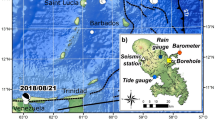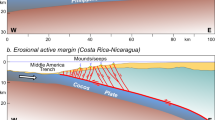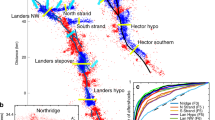Abstract
Earthquakes have been observed to affect hydrological systems in a variety of ways—water well levels can change dramatically, streams can become fuller and spring discharges can increase at the time of earthquakes1,2,3,4,5,6,7. Distant earthquakes may even increase the permeability in faults8. Most of these hydrological observations can be explained by some form of permeability increase1,5. Here we use the response of water well levels to solid Earth tides to measure permeability over a 20-year period. At the time of each of seven earthquakes in Southern California, we observe transient changes of up to 24° in the phase of the water level response to the dilatational volumetric strain of the semidiurnal tidal components of wells at the Piñon Flat Observatory in Southern California. After the earthquakes, the phase gradually returns to the background value at a rate of less than 0.1° per day. We use a model of axisymmetric flow driven by an imposed head oscillation through a single, laterally extensive, confined, homogeneous and isotropic aquifer to relate the phase response to aquifer properties9. We interpret the changes in phase response as due to changes in permeability. At the time of the earthquakes, the permeability at the site increases by a factor as high as three. The permeability increase depends roughly linearly on the amplitude of seismic-wave peak ground velocity in the range of 0.21–2.1 cm s-1. Such permeability increases are of interest to hydrologists and oil reservoir engineers as they affect fluid flow and might determine long-term evolution of hydrological and oil-bearing systems. They may also be interesting to seismologists, as the resulting pore pressure changes can affect earthquakes by changing normal stresses on faults10.
This is a preview of subscription content, access via your institution
Access options
Subscribe to this journal
Receive 51 print issues and online access
$199.00 per year
only $3.90 per issue
Buy this article
- Purchase on Springer Link
- Instant access to full article PDF
Prices may be subject to local taxes which are calculated during checkout




Similar content being viewed by others
References
Rojstaczer, S. & Wolf, S. Permeability changes associated with large earthquakes: An example from Loma Prieta, California. Geology 20, 211–214 (1992)
Muir-Wood, R. & King, G. Hydrological signatures of earthquake strain. J. Geophys. Res. 98, 22035–22068 (1993)
Roeloffs, E. Poroelastic techniques in the study of earthquakes-related hydrologic phenomena. Adv. Geophys. 37, 135–195 (1996)
Matsumoto, N. Regression-analysis for anomalous changes of ground-water level due to earthquakes. Geophys. Res. Lett. 19, 1193–1196 (1992)
Brodsky, E. E., Roeloffs, E., Woodcock, D., Gall, I. & Manga, M. A mechanism for sustained groundwater pressure changes induced by distant earthquakes. J. Geophys. Res. 108, doi:10.1029/2002JB002321 (2003)
Montgomery, D. & Manga, M. Stream flow and water well responses to earthquakes. Science 300, 2047–2049 (2003)
Manga, M., Brodsky, E. E. & Boone, M. Response of stream flow to multiple earthquakes. Geophys. Res. Lett. 30, doi:10.1029/2002GL016618 (2003)
Kitagawa, Y., Fujimori, K. & Koizumi, N. Temporal change in permeability of the rock estimated from repeated water injection experiments near the Nojima fault in Awaji Island, Japan. Geophys. Res. Lett. 29, doi:10.1029/2001GL014030 (2002)
Hsieh, P., Bredehoeft, J. & Farr, J. Determination of aquifer transmissivity from earthtide analysis. Water Resour. Res. 23, 1824–1832 (1987)
Raleigh, C., Healy, J. & Bredehoeft, J. An experiment in earthquake control at Rangely, Colorado. Science 191, 1230–1237 (1976)
Bower, D. R. & Heaton, K. C. Response of an aquifer near Ottawa to tidal forcing and the Alaskan earthquake of 1964. Can. J. Earth Sci. 15, 331–340 (1978)
Davis, E. E. & Elderfield, H. Hydrogeology of the Oceanic Lithosphere Fig. 8.16 (Cambridge Univ. Press, Cambridge, UK, 2004)
Wyatt, F. Displacement of surface monuments: horizontal motion. J. Geophys. Res. 87, 979–989 (1982)
Love, A. E. H. Mathematical Theory of Elasticity 298 (Cambridge Univ. Press, Cambridge, UK, 1927)
Coble, R. The effects of the Alaskan earthquake of March 27, 1964, on ground water in Iowa. Iowa Acad. Sci. 72, 323–332 (1965)
King, C. Y., Azuma, S., Igarashi, G., Ohno, M., Saito, H. & Wakita, H. Earthquake-related water-level changes at 16 closely clustered wells in Tono, Central Japan. J. Geophys. Res. 104, 13073–13082 (1999)
Brace, W. A note on permeability changes in geologic material due to stress. Pure Appl. Geophys. 116, 627–633 (1978)
Beresnev, I. A. & Johnson, P. A. Elastic-wave stimulation of oil production: A review of methods and results. Geophysics 85, 1000–1017 (1994)
Bower, D. R. Bedrock fracture parameters from the interpretation of well tides. J. Geophys. Res. 88, 5025–5035 (1983)
Cooper, H., Bredeheoft, J., Papadopulos, I. & Bennett, R. The response of well-aquifer systems to seismic waves. J. Geophys. Res. 70, 3915–3926 (1965)
Kanamori, H. et al. Determinations of earthquake energy release and ML using Terrascope. Bull. Seismol. Soc. Am. 83, 330–346 (1993)
Hardebeck, J. L. & Shearer, P. M. Using s/p amplitude ratios to constrain the focal mechanisms of small earthquakes. Bull. Seismol. Soc. Am. 93, 2434–2444 (2003)
Acknowledgements
These measurements would not have been available without the long-term support of the PFO by the NSF, SCEC, the Vetlesen fund of the Scripps Institution, and the US Geological Survey; and the efforts of F. Wyatt, L. Weuve, S. Bralla, and S. Docktor. We gratefully acknowledge comments and discussion from E. Cochran, P. Davis, Z. Peng, A. Sagy and J. Vidale. J.E.E. was supported by a CIED scholarship and an NSF award.
Author information
Authors and Affiliations
Corresponding author
Ethics declarations
Competing interests
Reprints and permissions information is available at npg.nature.com/reprintsandpermissions. The authors declare no competing financial interests.
Supplementary information
Supplementary Notes
This file contains Supplementary Methods, Supplementary Figures 1–5 and additional references. (PDF 4597 kb)
Rights and permissions
About this article
Cite this article
Elkhoury, J., Brodsky, E. & Agnew, D. Seismic waves increase permeability. Nature 441, 1135–1138 (2006). https://doi.org/10.1038/nature04798
Received:
Accepted:
Issue Date:
DOI: https://doi.org/10.1038/nature04798
This article is cited by
-
Changes in well water level and rock damage zones in a shallow aquifer before and after local earthquakes
Hydrogeology Journal (2023)
-
A Comprehensive Review of Factors Affecting Dynamic Capillary Effect in Two-Phase Flow
Transport in Porous Media (2022)
-
Experimental Investigation of Elastodynamic Nonlinear Response of Dry Intact, Fractured and Saturated Rock
Rock Mechanics and Rock Engineering (2022)
-
Role of the confined aquifer in the mechanism of soil liquefaction due to the 7.5 Mw earthquake in Palu (Indonesia) on 28 September 2018
Hydrogeology Journal (2022)
-
The Frictional Restrengthening and Permeability Evolution of Slipping Shale Fractures During Seismic Cycles
Rock Mechanics and Rock Engineering (2022)
Comments
By submitting a comment you agree to abide by our Terms and Community Guidelines. If you find something abusive or that does not comply with our terms or guidelines please flag it as inappropriate.



